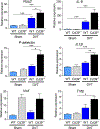Tuning the Thromboinflammatory Response to Venous Flow Interruption by the Ectonucleotidase CD39
- PMID: 30816804
- PMCID: PMC6467508
- DOI: 10.1161/ATVBAHA.119.312407
Tuning the Thromboinflammatory Response to Venous Flow Interruption by the Ectonucleotidase CD39
Abstract
Objective- Leukocyte flux contributes to thrombus formation in deep veins under pathological conditions, but mechanisms that inhibit venous thrombosis are incompletely understood. Ectonucleotide di(tri)phosphohydrolase 1 ( ENTPD1 or Cd39), an ectoenzyme that catabolizes extracellular adenine nucleotides, is embedded on the surface of endothelial cells and leukocytes. We hypothesized that under venous stasis conditions, CD39 regulates inflammation at the vein:blood interface in a murine model of deep vein thrombosis. Approach and Results- CD39-null mice developed significantly larger venous thrombi under venous stasis, with more leukocyte recruitment compared with wild-type mice. Gene expression profiling of wild-type and Cd39-null mice revealed 76 differentially expressed inflammatory genes that were significantly upregulated in Cd39-deleted mice after venous thrombosis, and validation experiments confirmed high expression of several key inflammatory mediators. P-selectin, known to have proximal involvement in venous inflammatory and thrombotic events, was upregulated in Cd39-null mice. Inferior vena caval ligation resulted in thrombosis and a corresponding increase in both P-selectin and VWF (von Willebrand Factor) levels which were strikingly higher in mice lacking the Cd39 gene. These mice also manifest an increase in circulating platelet-leukocyte heteroaggregates suggesting heterotypic crosstalk between coagulation and inflammatory systems, which is amplified in the absence of CD39. Conclusions- These data suggest that CD39 mitigates the venous thromboinflammatory response to flow interruption.
Keywords: P-selectin; endothelial cells; inflammation; leukocytes; venous thrombosis.
Conflict of interest statement
DISCLOSURES
The authors declare no relevant disclosures.
Figures









Similar articles
-
Ectonucleotidase tri(di)phosphohydrolase-1 (ENTPD-1) disrupts inflammasome/interleukin 1β-driven venous thrombosis.J Clin Invest. 2019 Apr 16;129(7):2872-2877. doi: 10.1172/JCI124804. J Clin Invest. 2019. PMID: 30990798 Free PMC article.
-
Self-regulation of inflammatory cell trafficking in mice by the leukocyte surface apyrase CD39.J Clin Invest. 2009 May;119(5):1136-49. doi: 10.1172/JCI36433. Epub 2009 Apr 20. J Clin Invest. 2009. PMID: 19381014 Free PMC article.
-
Ectonucleotidases of CD39 family modulate vascular inflammation and thrombosis in transplantation.Semin Thromb Hemost. 2005 Apr;31(2):217-33. doi: 10.1055/s-2005-869527. Semin Thromb Hemost. 2005. PMID: 15852225 Review.
-
Role of the CD39/CD73 Purinergic Pathway in Modulating Arterial Thrombosis in Mice.Arterioscler Thromb Vasc Biol. 2016 Sep;36(9):1809-20. doi: 10.1161/ATVBAHA.116.307374. Epub 2016 Jul 14. Arterioscler Thromb Vasc Biol. 2016. PMID: 27417582 Free PMC article.
-
Role of CD39 (NTPDase-1) in thromboregulation, cerebroprotection, and cardioprotection.Semin Thromb Hemost. 2005 Apr;31(2):234-46. doi: 10.1055/s-2005-869528. Semin Thromb Hemost. 2005. PMID: 15852226 Review.
Cited by
-
Gab2 (Grb2-Associated Binder2) Plays a Crucial Role in Inflammatory Signaling and Endothelial Dysfunction.Arterioscler Thromb Vasc Biol. 2021 Jun;41(6):1987-2005. doi: 10.1161/ATVBAHA.121.316153. Epub 2021 Apr 8. Arterioscler Thromb Vasc Biol. 2021. PMID: 33827252 Free PMC article.
-
Ectonucleoside Triphosphate Diphosphohydrolase-1/CD39 Affects the Response to ADP of Female Rat Platelets.Front Pharmacol. 2020 Jan 31;10:1689. doi: 10.3389/fphar.2019.01689. eCollection 2019. Front Pharmacol. 2020. PMID: 32082171 Free PMC article.
-
Inflammasome Signaling, Thromboinflammation, and Venous Thromboembolism.JACC Basic Transl Sci. 2023 Jun 7;8(9):1245-1261. doi: 10.1016/j.jacbts.2023.03.017. eCollection 2023 Sep. JACC Basic Transl Sci. 2023. PMID: 37791298 Free PMC article. Review.
-
Effects of physical exercise on the functionality of human nucleotidases: A systematic review.Physiol Rep. 2022 Sep;10(18):e15464. doi: 10.14814/phy2.15464. Physiol Rep. 2022. PMID: 36117383 Free PMC article.
-
Inflammation, Infection and Venous Thromboembolism.Circ Res. 2021 Jun 11;128(12):2017-2036. doi: 10.1161/CIRCRESAHA.121.318225. Epub 2021 Jun 10. Circ Res. 2021. PMID: 34110909 Free PMC article. Review.
References
-
- Silverstein MD, Heit JA, Mohr DN, Petterson TM, O’Fallon WM, Melton LJ 3rd. Trends in the incidence of deep vein thrombosis and pulmonary embolism: A 25-year population-based study. Arch Intern Med. 1998;158:585–593 - PubMed
-
- Bureau. USC. Monthly populations estimates for the united states: April 1, 2010 to december 1, 2012. Population Estimates. 2012;2012
-
- Yusuf HR, Tsai J, Atrash HK, Boulet S, Gross SD. Venous thromboembolism in adult hospitalizations-united states, 2007–2009. Atlanta, Ga: U.S. Dept. of Health and Human Services, Centers for Disease Control and Prevention; 2012.
-
- Center for Diseases Control. Venous thromboembolism.2018
-
- Ocak G, Vossen CY, Verduijn M, Dekker FW, Rosendaal FR, Cannegieter SC, Lijfering WM. Risk of venous thrombosis in patients with major illnesses: Results from the mega study. J Thromb Haemost. 2012 - PubMed
Publication types
MeSH terms
Substances
Grants and funding
LinkOut - more resources
Full Text Sources
Medical
Molecular Biology Databases
Research Materials
Miscellaneous

